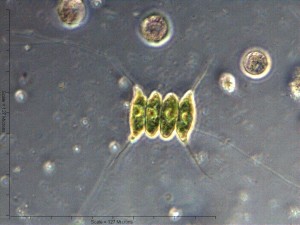Case Study | Algae Control
Surface water quality in ponds, water depots, canals, rivers and lakes is influenced by the influx of contaminants from human discharge, agriculture, industry and animal life in and on the water.
Fertilization in agriculture or on golf courses, discharge of treated or untreated sewage, industrial chemical discharge or even an overload of excrement from water birds and even fish will seriously affect the water quality of the receiving waterbody. This can lead to algae blooms (eutrophication) of green and blue algae and even lead to the complete starvation of the aquatic life (distrophication).
An algal bloom or marine bloom or water bloom is a rapid increase in the population of algae in an aquatic system. Algal blooms may occur in freshwater as well as marine environments.
Typically only one or a few phytoplankton species are involved and some blooms may be recognized by discoloration of the water resulting from the high density of pigmented cells.
Although there is no officially recognized threshold level, algae can be considered to be blooming at concentrations of hundreds to thousands of cells per milliliter, depending on the causative species.
Algal bloom concentrations may reach millions of cells per milliliter.
Colors observed are green, yellowish-brown, or red. Bright green blooms may also occur.
These are a result of blue-green algae, which are actually bacteria (cyanobacteria).
Some algal blooms are the result of an excess of nutrients (particularly phosphorus and nitrogen) into waters and higher concentrations of these nutrients in water cause increased growth of algae and green plants.

Scenedesmus, an algae frequently seen in surface water and wastewater treatment ponds and lagoons.
It’s presence indicates nitrogen and phosphorus nutrients are available.
As more algae and plants grow, others die. This dead organic matter becomes food for bacteria that decompose it. With more food available, the bacteria increase in number and use up the dissolved oxygen in the water. When the dissolved oxygen content decreases, many fish and aquatic insects cannot survive. This results in a dead area.
Algal blooms may also be of concern as some species of algae produce neurotoxins.
At the high cell concentrations reached during some blooms, these toxins may have severe biological impacts on wildlife. Algal blooms composed of phytoplankters known to naturally produce biotoxins are often called Harmful Algal Blooms, or HABs.
Bioaugmentation
Bioaugmentation can help restore water quality and keep algae growth under control by taking up the nutrients used by the algae, e.g. nitrogen and phosphorous compounds.
Case study Zoo pond solids control
This case study describes how bioaugmentation quickly restored a ZOO pond experiencing heavy algae growth prior to anniversary.
Case study Farm Pond Solids Control
This case study describes the treatment of a farm pond receiving run off waters which create algae blooms during warm weather situations and subsequent fish starvation.